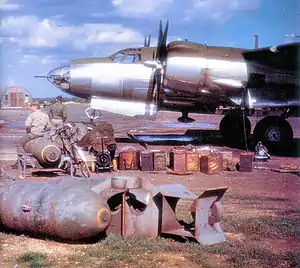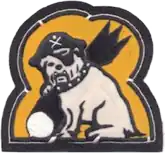494th Bombardment Squadron
The 494th Bombardment Squadron is an inactive United States Air Force unit, assigned to the 344th Bombardment Group, The squadron was activated in September 1942, and until July 1943 served as a Replacement Training Unit. It then began training for combat operations, deploying to the European Theater of Operations in January 1944. It participated in combat, earning a Distinguished Unit Citation for air support of ground troops during Operation Cobra. After V-E Day, the squadron became part of the occupation forces until it was inactivated on 31 March 1946.
| 494th Bombardment Squadron | |
|---|---|
 344th Group B-26 Marauders at RAF Stansted Mountfitchet | |
| Active | 1942-1946 |
| Country | |
| Branch | |
| Role | Medium bomber |
| Engagements | European Theater of Operations |
| Decorations | Distinguished Unit Citation |
| Insignia | |
| 494th Bombardment Squadron emblem[1][note 1] |  |
| Fuselage code [2] | K9 |
History
Training in the United States
The squadron was activated in September 1943 at MacDill Field, Florida as one of the original squadrons of the 344th Bombardment Group. In December, the group moved to nearby Drane Field, Florida. The unit served as a Replacement Training Unit (RTU) for Martin B-26 Marauders.[1] RTUs were oversized units to that trained individual pilots or aircrews.[3]
In July 1943, the squadron stopped training other crews and began training to enter combat. It completed its training at Hunter Field, Georgia, and departed for the European Theater of Operations on 26 January 1944.[1]
Combat in Europe
The squadron arrived at its first combat station, RAF Stansted Mountfitchet on 8 February 1944, where the unit became part of IX Bomber Command. The squadronngaged in tactical bombardment of enemy targets in Occupied Europe initially from stations in England, then after D-Day, moved to Advanced Landing Grounds in France and Belgium; advancing eastward as Allied ground forces advanced. Supported Eighth Air Force strategic bombardment missions over Germany and Occupied Europe; striking enemy airfields to obtain maximum interference in Luftwaffe day interceptor attacks on heavy bomber formations returning to England. Also participated in Western Allied Invasion of Germany, March–April 1945, combat ending with German Capitation in May 1945.[1][4]
Occupation duty and return to the United States
The squadron remained in Germany as part of the United States Air Forces in Europe's occupation forces, moving to Schleissheim Airfield, near Munich, in September. In late 1945, the squadron began training on the Douglas A-26 Invader, but continued to fly Marauders as well. On 15 February 1946, the squadron's personnel and aircraft were withdrawn and it moved on paper to Bolling Field, District of Columbia, where it inactivated at the end of March.[1][4]
Lineage
- Constituted as the 494th Bombardment Squadron (Medium) on 31 August 1942
- Activated on 8 September 1942
- Redesignated 494th Bombardment Squadron, Medium in 1944
- Redesignated 494th Bombardment Squadron, Light on 3 December 1945
- Inactivated on 30 December 1945[1]
Assignments
- 344th Bombardment Group, 8 September 1942 – 31 March 1946[1]
Stations
- MacDill Field, Florida, 8 September 1942
- Drane Field, Florida, 28 December 1942
- Hunter Field, Georgia, 19 December 1943 – 26 January 1944
- RAF Stansted Mountfitchet (AAF-169),[5] England, 8 February 1944
- Cormeilles-en-Vexin Airfield (A-59),[6] France, 30 September 1944
- Florennes/Juzaine Airfield (A-78),[6] Belgium, 4 April 1945
- Schleissheim Airfield (R-75),[6] Germany, 15 September 1945 – 15 February 1946
- Bolling Field, District of Columbia, 15 February 1946 – 31 March 1946[7]
Aircraft
- Martin B-26 Marauder, 1942–1946
- Douglas A-26 Invader, 1945–1946[1]
References
Notes
- Explanatory notes
- Approved 7 July 1944. Maurer, Combat Squadrons, pp. 595-596.
- Citations
- Maurer, Combat Squadrons, pp. 595-596.
- Rust, p. 211
- Craven & Cate, Introduction, p. xxxvi
- Maurer, Combat Units, pp. 222-223
- Station number in Anderson.
- Station number in Johnson.
- Station information in Maurer, Combat Squadrons, pp. 595-596, except as noted.
Bibliography
![]() This article incorporates public domain material from the Air Force Historical Research Agency.
This article incorporates public domain material from the Air Force Historical Research Agency.
- Anderson, Barry (1985). Army Air Forces Stations: A Guide to the Stations Where U.S. Army Air Forces Personnel Served in the United Kingdom During World War II (PDF). Maxwell AFB, AL: Research Division, USAF Historical Research Center. Archived from the original (PDF) on 23 January 2016. Retrieved 28 June 2017.
- Goss, William A. (1955). "The Organization and its Responsibilities, Chapter 2 The AAF". In Craven, Wesley F; Cate, James L. (eds.). The Army Air Forces in World War II (PDF). Vol. VI, Men & Planes. Chicago, IL: University of Chicago Press. LCCN 48003657. OCLC 704158. Retrieved 17 December 2016.
- Johnson, 1st Lt. David C. (1988). U.S. Army Air Forces Continental Airfields (ETO) D-Day to V-E Day (PDF). Maxwell AFB, AL: Research Division, USAF Historical Research Center. Archived from the original (PDF) on 29 September 2015. Retrieved 26 June 2017.
- Maurer, Maurer, ed. (1982) [1969]. Combat Squadrons of the Air Force, World War II (PDF) (reprint ed.). Washington, DC: Office of Air Force History. ISBN 0-405-12194-6. LCCN 70605402. OCLC 72556.
- Maurer, Maurer, ed. (1982) [1969]. Combat Squadrons of the Air Force, World War II (PDF) (reprint ed.). Washington, DC: Office of Air Force History. ISBN 0-405-12194-6. LCCN 70605402. OCLC 72556. Retrieved 17 December 2016.
- Rust, Kenn C.; Hess, William N. (1960). The Slybird Group: The 353rd Fighter Group on Escort and Ground Attack Operations. Drawings by Matt, Paul R. and Preston, John. Fallbrook, CA: Aero Publishers, Inc. ISBN 978-0-81689-762-9. LCCN 67-27872.